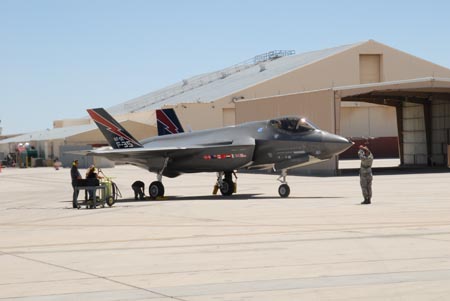Another F-35A IOC Slip Looms
The  Air Force may have to wait up to two additional years beyond the current estimate before its first unit of F-35A strike fighters is declared ready for operations, according to two senior service officials. Last June, Air Combat Command estimated that it would be able to reach initial operational capability with the F-35A in 2016. But this may change depending on the outcome of subsequent ongoing analysis weighing the impacts of the most recent F-35 program changes, said Lt. Gen. Herbert Carlisle, deputy chief of staff for operations, plans, and requirements, and Lt. Gen. Mark Shackelford, military deputy to USAF's acquisition executive, in a joint statement submitted to the House Armed Services Committee's tactical air and land forces panel Tuesday. "When this analysis is complete [later this year], the Air Force will reevaluate our IOC estimate, but we currently expect up to a two-year delay," they wrote. (Carlisle-Shackelford prepared testimony) (See also DOD F-35 fact sheet outlining program changes.)
Air Force may have to wait up to two additional years beyond the current estimate before its first unit of F-35A strike fighters is declared ready for operations, according to two senior service officials. Last June, Air Combat Command estimated that it would be able to reach initial operational capability with the F-35A in 2016. But this may change depending on the outcome of subsequent ongoing analysis weighing the impacts of the most recent F-35 program changes, said Lt. Gen. Herbert Carlisle, deputy chief of staff for operations, plans, and requirements, and Lt. Gen. Mark Shackelford, military deputy to USAF's acquisition executive, in a joint statement submitted to the House Armed Services Committee's tactical air and land forces panel Tuesday. "When this analysis is complete [later this year], the Air Force will reevaluate our IOC estimate, but we currently expect up to a two-year delay," they wrote. (Carlisle-Shackelford prepared testimony) (See also DOD F-35 fact sheet outlining program changes.)
 Air Force may have to wait up to two additional years beyond the current estimate before its first unit of F-35A strike fighters is declared ready for operations, according to two senior service officials. Last June, Air Combat Command estimated that it would be able to reach initial operational capability with the F-35A in 2016. But this may change depending on the outcome of subsequent ongoing analysis weighing the impacts of the most recent F-35 program changes, said Lt. Gen. Herbert Carlisle, deputy chief of staff for operations, plans, and requirements, and Lt. Gen. Mark Shackelford, military deputy to USAF's acquisition executive, in a joint statement submitted to the House Armed Services Committee's tactical air and land forces panel Tuesday. "When this analysis is complete [later this year], the Air Force will reevaluate our IOC estimate, but we currently expect up to a two-year delay," they wrote. (Carlisle-Shackelford prepared testimony) (See also DOD F-35 fact sheet outlining program changes.)
Air Force may have to wait up to two additional years beyond the current estimate before its first unit of F-35A strike fighters is declared ready for operations, according to two senior service officials. Last June, Air Combat Command estimated that it would be able to reach initial operational capability with the F-35A in 2016. But this may change depending on the outcome of subsequent ongoing analysis weighing the impacts of the most recent F-35 program changes, said Lt. Gen. Herbert Carlisle, deputy chief of staff for operations, plans, and requirements, and Lt. Gen. Mark Shackelford, military deputy to USAF's acquisition executive, in a joint statement submitted to the House Armed Services Committee's tactical air and land forces panel Tuesday. "When this analysis is complete [later this year], the Air Force will reevaluate our IOC estimate, but we currently expect up to a two-year delay," they wrote. (Carlisle-Shackelford prepared testimony) (See also DOD F-35 fact sheet outlining program changes.)